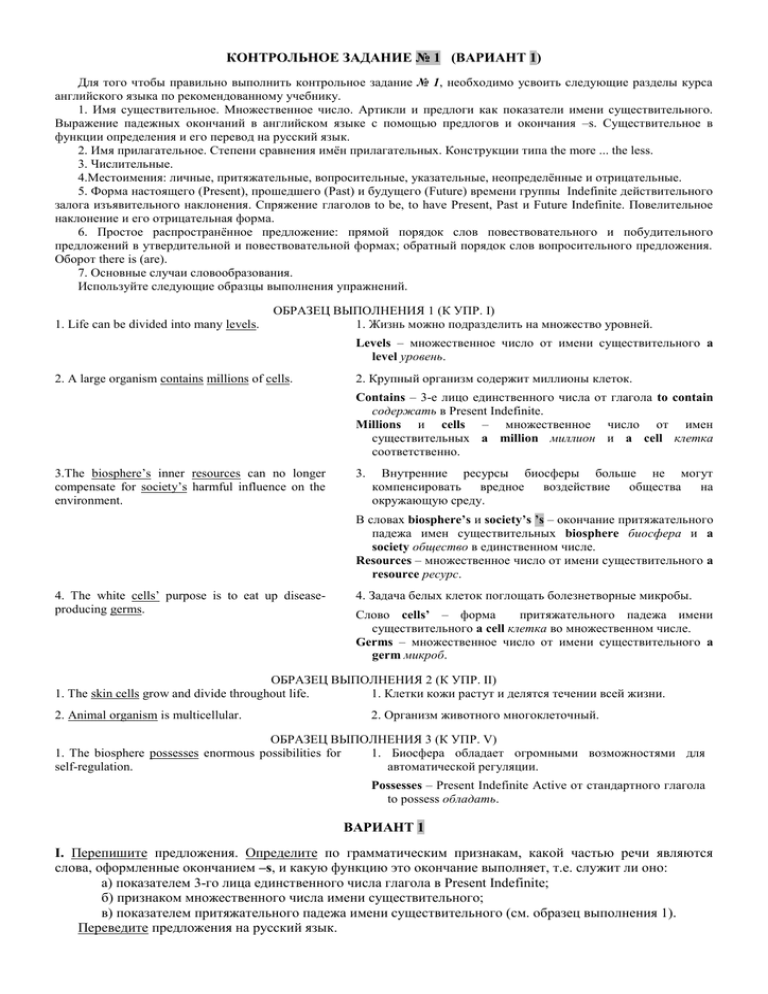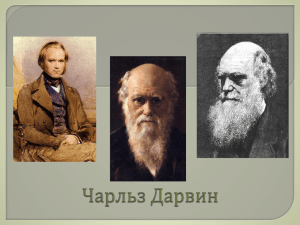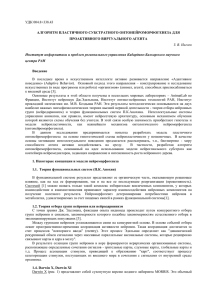КОНТРОЛЬНАЯ РАБОТА № 1
advertisement

КОНТРОЛЬНОЕ ЗАДАНИЕ № 1 (ВАРИАНТ 1) Для того чтобы правильно выполнить контрольное задание № 1, необходимо усвоить следующие разделы курса английского языка по рекомендованному учебнику. 1. Имя существительное. Множественное число. Артикли и предлоги как показатели имени существительного. Выражение падежных окончаний в английском языке с помощью предлогов и окончания –s. Существительное в функции определения и его перевод на русский язык. 2. Имя прилагательное. Степени сравнения имён прилагательных. Конструкции типа the more ... the less. 3. Числительные. 4.Местоимения: личные, притяжательные, вопросительные, указательные, неопределённые и отрицательные. 5. Форма настоящего (Present), прошедшего (Past) и будущего (Future) времени группы Indefinite действительного залога изъявительного наклонения. Спряжение глаголов to be, to have Present, Past и Future Indefinite. Повелительное наклонение и его отрицательная форма. 6. Простое распространённое предложение: прямой порядок слов повествовательного и побудительного предложений в утвердительной и повествовательной формах; обратный порядок слов вопросительного предложения. Оборот there is (are). 7. Основные случаи словообразования. Используйте следующие образцы выполнения упражнений. 1. Life can be divided into many levels. ОБРАЗЕЦ ВЫПОЛНЕНИЯ 1 (К УПР. I) 1. Жизнь можно подразделить на множество уровней. Levels – множественное число от имени существительного a level уровень. 2. A large organism contains millions of cells. 2. Крупный организм содержит миллионы клеток. Contains – 3-е лицо единственного числа от глагола to contain содержать в Present Indefinite. Millions и cells – множественное число от имен существительных a million миллион и a cell клетка соответственно. 3.The biosphere’s inner resources can no longer compensate for society’s harmful influence on the environment. 3. Внутренние ресурсы биосферы больше не могут компенсировать вредное воздействие общества на окружающую среду. В словах biosphere’s и society’s ’s – окончание притяжательного падежа имен существительных biosphere биосфера и a society общество в единственном числе. Resources – множественное число от имени существительного a resource ресурс. 4. The white cells’ purpose is to eat up diseaseproducing germs. 4. Задача белых клеток поглощать болезнетворные микробы. Слово cells’ – форма притяжательного падежа имени существительного a cell клетка во множественном числе. Germs – множественное число от имени существительного a germ микроб. ОБРАЗЕЦ ВЫПОЛНЕНИЯ 2 (К УПР. II) 1. The skin cells grow and divide throughout life. 1. Клетки кожи растут и делятся течении всей жизни. 2. Animal organism is multicellular. 2. Организм животного многоклеточный. ОБРАЗЕЦ ВЫПОЛНЕНИЯ 3 (К УПР. V) 1. The biosphere possesses enormous possibilities for 1. Биосфера обладает огромными возможностями для self-regulation. автоматической регуляции. Possesses – Present Indefinite Active от стандартного глагола to possess обладать. ВАРИАНТ 1 I. Перепишите предложения. Определите по грамматическим признакам, какой частью речи являются слова, оформленные окончанием –s, и какую функцию это окончание выполняет, т.е. служит ли оно: а) показателем 3-го лица единственного числа глагола в Present Indefinite; б) признаком множественного числа имени существительного; в) показателем притяжательного падежа имени существительного (см. образец выполнения 1). Переведите предложения на русский язык. 1. Several Gomel State University biologists work at this problem. 2. Darwin’s theory of evolution stimulated studies in biology. 3. The cell contains a number of inorganic substances. II. Перепишите следующие предложения и переведите их, обращая внимание на особенности перевода на русский язык определений, выраженных именем существительным (см. образец выполнения 2). 1. Mud and stone streams inflict great damage. 2. Nerve cells have irregular shapes. 3. The water level is determined not only by the rainfall. III. Перепишите следующие предложения, содержащие разные формы сравнения, и переведите их на русский язык. 1. Nucleus is denser and thicker than the rest of the cell. 2. The more factories appear, the less fresh air we breathe. 3. Charles Darwin is the most famous British naturalist. IV. Перепишите и переведите предложения на русский язык, обращая внимание на перевод неопределенных и отрицательных местоимений. 1. Some of the experiments with these plants were successful. 2. No problem is insoluble. 3. Were there any microscopes in the laboratory? V. Перепишите следующие предложения, определите в них видо-временные формы глаголов и укажите их инфинитив; переведите предложения на русский язык (см. образец выполнения 3). 1. Darwin studied medicine at the University of Edinburgh. 2. Cells compose all living things. 3. Someday people will understand the necessity of environmental protection. VI. Прочтите и устно переведите на русский язык с 1-го по 6-й абзацы текста. Перепишите и письменно переведите 1, 3, 4 и 5-й абзацы. Пояснения к тексту 1. to evolve – эволюционировать 2. related – родственный; связанный, схожий 3. through – посредством, благодаря CHARLES DARWIN 1. Charles Darwin (1809-1882) was a British naturalist who became famous for his theories on evolution. Like several other scientists before him, Darwin believed that, through millions of years, all species of plants and animals had evolved from a few common ancestors. 2. Darwin’s theories included several related ideas. They were: 1) that evolution had occurred; 2) that most evolutionary change are gradual, requiring thousands or millions of years; 3) that primary mechanism for evolution was a process called natural selection, and 4) that the millions of species present on earth today arose from a single original life form through a branching process called speciation, by which one species can give rise to two or more species. 3. Darwin’s theories shocked most people of his day, who believed that each species had been created by a separate divine act. His book, which is usually called simply The Origin of Species, presented facts that refuted this belief. It caused a revolution in biological science and greatly affected religious thought. 4. Darwin wrote several books that further discussed his theories of evolution. These included The Descent of Man and Selection in Relation to Sex and The Expression of the Emotions in Man and Animals. Darwin’s theories of evolution through natural selection set off a bitter controversy among biologists, religious leaders, and the general public. Many people thought Darwin had implied that human beings were descended from monkeys, and they angrily criticized his evolutionary ideas. 5. These theories, and the facts that supported them, gave biologists new insight into the origin of living things and the relationship among various species. Darwin’s theory of evolution by natural selection stimulated studies in biology, particularly in paleontology and comparative anatomy. 6. After World War 2 Darwin’s theories became the dominant influence in evolutionary biology in a form often called Neo-Darwinism. Neo-Darwinism gave a fuller explanation for the genetic origin of variation within individual species and for how species are formed. VII. Прочтите 2-й абзац текста и вопрос к нему. Выберите и перепишите правильный вариант ответа. What ideas do Darwin’s theories include? 1. Each species had been created by a separate divine act. 2. Evolution had occurred. 3. There is no struggle for life.

